CloudStation vs. Fly.io

Choosing the right platform for deploying web applications is crucial for the success of your project. This guide explores the key differences between CloudStation and Fly.io, two popular platforms for cloud deployment. Understanding their core features will help you make an informed decision.
Key Differences
Deployment Focus
- CloudStation:
- Full-stack deployment capabilities, including frontend, backend, databases, and microservices.
- Includes features such as SSD-based storage and private networking.
- Fly.io:
- Developer-centric platform focused on running applications globally close to users via Anycast networking.
- Supports containerized applications with advanced networking customization.
Database Support
- CloudStation:
- Offers built-in databases like PostgreSQL and MySQL with features such as auto-scaling and snapshots.
- Fly.io:
- Does not provide built-in databases but can integrate with external database services.
Microservices Architecture
- CloudStation:
- Supports native Docker, monorepos, and independent service deployments.
- Fly.io:
- Leverages containerized applications and provides advanced networking capabilities for microservices.
Persistent Storage
- CloudStation:
- Includes persistent storage volumes for stateful applications.
- Fly.io:
- Primarily operates on a stateless architecture but allows for persistent storage through external integrations.
Pricing Structure
- CloudStation:
- Utilizes a pay-as-you-go model for flexible and scalable pricing based on usage.
- Fly.io:
- Pricing is based on resource usage and location, which can be more complex depending on specific needs.
Horizontal Scaling
- CloudStation:
- Offers horizontal scaling across all tiers.
- Fly.io:
- Provides horizontal scaling but can be cost-effective depending on specific geographic needs.
Global Deployments
- CloudStation:
- Allows deployments in multiple global locations to reduce latencies.
- Fly.io:
- Prioritizes deploying applications close to users globally through its Anycast network.
Private Network and Service Discovery
- CloudStation:
- Includes built-in service discovery and encrypted inter-service communications.
- Fly.io:
- Allows for advanced networking customizations, including service discovery features.
Autohealing
- CloudStation:
- Provides TCP and HTTP health checks, automatically respawning unresponsive applications.
- Fly.io:
- Emphasizes performance and networking with health check capabilities.
Multicloud Support
- CloudStation:
- Is cloud-agnostic, delivering a consistent experience across multiple cloud providers.
- Fly.io:
- Primarily relies on its own global infrastructure but can integrate with other cloud services if needed.
Data Residency and Compliance
- CloudStation:
- Supports multi-region deployments to meet data residency and compliance requirements.
- Fly.io:
- Offers global deployment options that can align with data residency and compliance needs.
Conclusion
Your choice between CloudStation and Fly.io should align with your project's specific requirements. CloudStation is ideal for full-stack development with integrated database management and microservices. It excels in offering a user-friendly, feature-rich environment. In contrast, Fly.io is best suited for applications needing high performance and low latency through global deployments. Consider your project scale, deployment needs, and feature requirements when making your decision.
FAQs
Which platform is better for beginners?
CloudStation is generally more user-friendly for beginners due to its simpler setup and management.
Can CloudStation support high-traffic applications?
Yes, CloudStation efficiently handles high-traffic applications with robust scaling capabilities.
What are the cost benefits of choosing Fly.io over CloudStation?
Fly.io can be more cost-effective for applications that benefit from geographical distribution and advanced networking customizations.
How do deployment times compare between the two platforms?
Both platforms offer competitive deployment times, but the specific setup and requirements of each project can impact overall speed.
Which platform offers better support for real-time applications?
Both platforms are capable of supporting real-time applications, but Fly.io's emphasis on low-latency deployments close to users can provide an edge for certain use cases.
